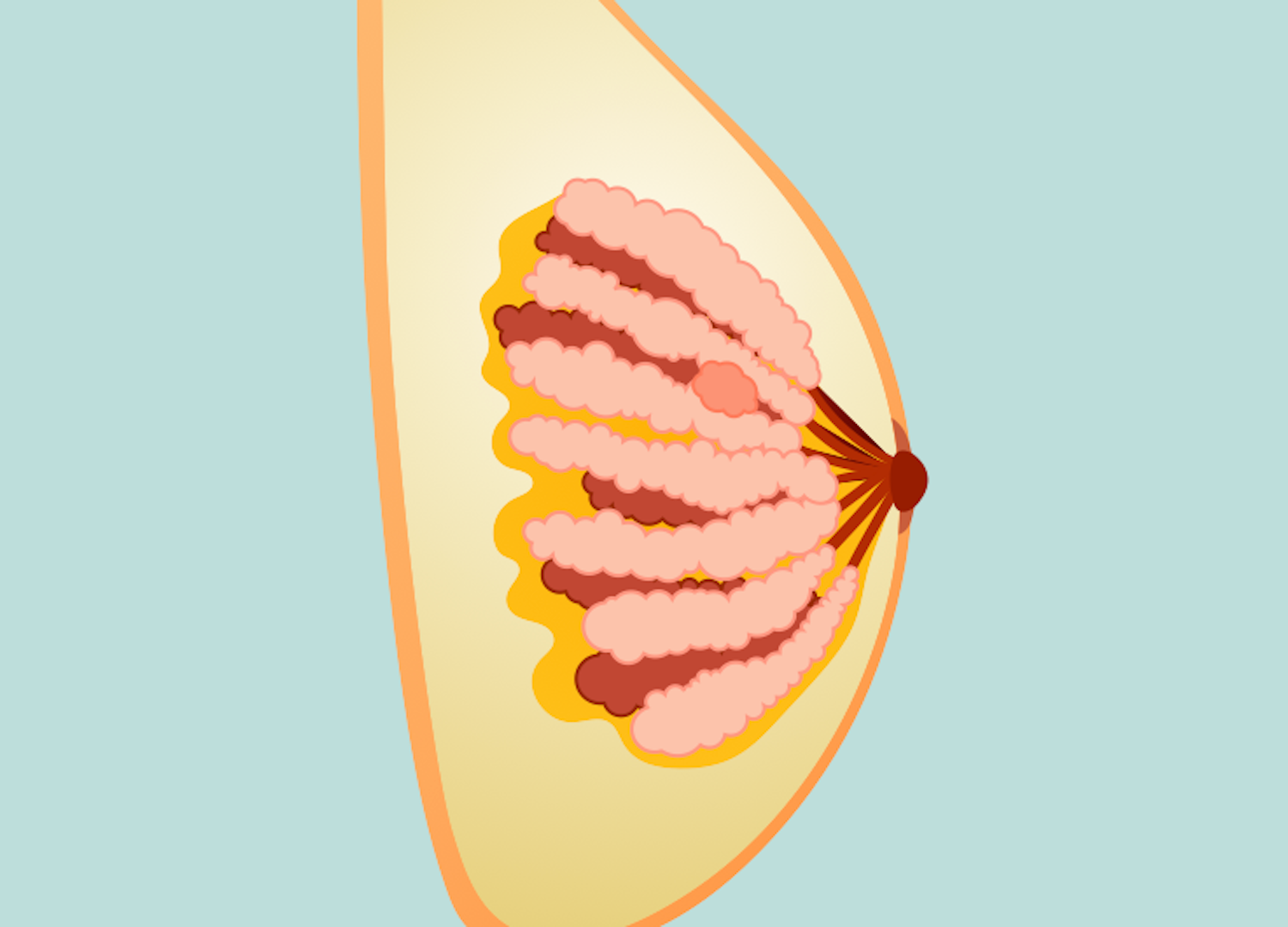Breast fibroadenomas are benign, solid tumors made of stromal and epithelial elements.
Epidemiology
- Second most common tumor in the breast
- Most common tumor in women < 30 years
- Rare in women > 40 years
Pathogenesis
- Stromal overgrowth with collagen arranged in “swirls”
- Thought to be influenced by ovarian hormones
History
- Painless breast mass
- Changes with menstrual cycle (grow with pregnant or hormone therapy; shrink after menopause)
Physical Exam
- Mass often occurs in upper outer quadrant of the breast
- Mass characteristics
- Unilateral
- Nontender/painless
- Firm, rubbery
- Well-circumscribed
- Smooth or lobulated
Imaging
- Initial imaging
- Age < 30 → breast US
- Age 30 – 39 → either breast US or diagnostic mammogram
- Age ≥ 40 → diagnostic mammogram
- Core needle biopsy if initial imaging yields suspicious findings
- Mammography isn’t helpful for distinguishing between breast cysts and fibroadenomas
- Findings:
- Breast US: oval or round hypoechoic mass with circumscribed border
- Mammogram: oval or round mass with circumscribed margin, can have coarse calcifications (popcorn lesions) from degeneration
Treatment
- Generally
- Small fibroadenomas → observed
- Large/growing fibroadenomas → surgical excision
- When a tissue diagnosis confirms fibroadenoma, surgical excision isn’t needed
- Patients ≤ 35 years → need the following to qualify for observation (and not require excision)
- Mass characteristics: firm, rubbery, rolls, not fixed
- US or mammogram consistent with fibroadenoma
- Needle core biopsy consistent with fibroadenoma
- Patients > 35 years → excisional biopsy to ensure diagnosis (or core needle biopsy if attempting 1-step surgery)
- Surgical excision
- Reveals a well-encapsulated mass that easily detaches from surrounding breast tissue (if it’s a fibroadenoma)
- Surgical techniques
- Lumpectomy or excisional biopsy
- Cryoablation
- Contraindications to surgical excision: fibroadenomas < 2 cm
Relevant Information
- Most common breast lesion in adolescents and young women
- Fibroadenoma subtypes
- Simple fibroadenoma
- Most common
- Don’t increase risk of cancer
- Often present as palpable mass
- Usually smaller (< 3 cm)
- Complex fibroadenoma
- Slightly increased risk of cancer
- Complex if any of the following
- Epithelial calcification
- Apocrine hyperplasia/metaplasia
- Sclerosing adenosis
- Breast cysts
- Treat with excisional biopsy
- Giant fibroadenoma
- > 5 cm (unusually large)
- Rapid growth
- Need to rule out phyllodes tumor
- Juvenile fibroadenoma
- Large fibroadenoma in women ages 10 – 18 years old
- Histologically more cellular than a usual fibroadenoma
- Tubular fibroadenoma: tightly packed epithelial component with sparse connective tissue; benign
- Simple fibroadenoma
- Histology: fibrous tissue compressing epithelial cells

- Breast anatomy
- Lies between subdermal layer of adipose tissue and superficial pectoral fascia
- Cooper ligaments
- Provide structural support and shape (anchored into the skin)
- Infiltration by tumors can produce tethering, resulting in dimpling on the breast tissue
- Lymphatics
- Lymph nodes
- Level 1: located lateral to the lateral border of the pectoralis minor muscle
- Level II: located posterior to the pectoralis minor muscle as well as anterior to the pectoralis minor and posterior to the pectoralis major (Rotter or interpectoral nodes)
- Level III: located medial to pectoralis minor muscle and include subclavicular nodes
- Most drains to axillary nodes (97%)
- Any quadrant can drain into internal mammary nodes
- Supraclavicular nodes → N3 disease
- Primary axillary adenopathy → ≤ 1 is lymphoma
- Lymph nodes
- Nerves
- Long thoracic nerve
- Innervates serratus anterior muscle
- Injury → winged scapula
- Lateral thoracic artery supplies serratus anterior muscle
- Thoracodorsal nerve
- Innervates latissimus dorsi muscle
- Injury → weak arm pull-ups and adduction
- Thoracodorsal artery supplies latissimus dorsi
- Arises from posterior cord of brachial plexus; enters axillary space under axillary vein (close to long thoracic nerve)
- Medial pectoral nerve: innervates innervates pectoralis major and pectoralis minor muscles
- Lateral pectoral nerve: innervates pectoralis major muscle
- Intercostobrachial nerve
- Lateral cutaneous branch of second intercostal nerve
- Sensation to medial arm and axilla
- Most common injured nerve with modified radical mastectomy (MRM) or axillary lymph node dissection (ALND)
- Long thoracic nerve
- Arterial supply: branches of
- Internal thoracic (mammary) artery
- Intercostal arteries
- Thoracoacromial artery
- Lateral thoracic artery
- Batson’s plexus: valveless vein plexus, allows direct hematogenous metastasis of breast cancer to spine
- Costoclavicular ligament (Halsted ligament): defines axilla apex
- Breast development
- Formed from ectoderm milk streak
- Hormone influence
- Estrogen: duct development (double layer of columnar cells)
- Progesterone: lobular development
- Prolactin: synergizes estrogen and progesterone
- Cyclic changes
- Estrogen → increased breast swelling, growth of glandular tissue
- Progesterone → increased maturation of glandular tissue, withdrawal causes menses
- FSH, LH surge → ovum release
- After menopause, less estrogen and progesterone results in atrophy of breast and vulvar tissue
- Microscopic anatomy
- Three tissue types
- Glandular epithelium
- Branching system of ducts arranged in a radial pattern extending from the nipple-areolar complex
- Each major duct has branches and ultimately ends in terminal ductules or acini (acini are milk-forming glands of lactating breasts)
- Fibrous stroma and supporting tissues
- Adipose tissue
- Glandular epithelium
- Basement membrane
- Contains laminin, type IV collagen, proteoglycans
- Differentiates in situ from invasive breast cancer
- Three tissue types
Complications
- Lobular carcinoma in situ (50%): stage 0
- Invasive carcinomas (35%)
- Intraductal carcinoma (15%)
- Breast cancer → rare (0.2%) in newly discovered fibroadenomas
Differential Diagnoses
- Breast cyst
- Breast carcinoma
- Phyllodes tumor
- Breast lymphoma
- Metastasis to breast from another primary site
Resources
- The American Society of Breast Surgeons. “Choosing Wisely: Benign Breast Disease,” (2023)
